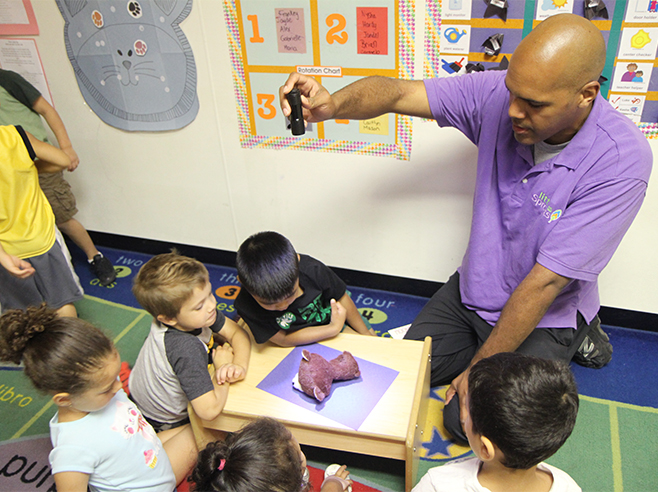Children act out story scenes, create shadows, and describe shadow positions using illustrations from the book Moonbear’s Shadow, by Frank Asch.
Materials

- Cool Shadows tool in the Shadows Journal on an iPad
- Bright flashlight or LED lamp with an adjustable head
- Moonbear’s Shadow by Frank Asch
- Shadow surface (such as a large sheet of white paper or a white sheet)
- Stuffed toy bear or other object (to use as the “puppet”)
- Positional Words Chart (PDF)
Preparation
- Review the story Moonbear’s Shadow, by Frank Asch.
- Display the Positional Words Chart on the wall or an iPad.
- Place materials in the shadow area. Set up the area and include a light and a shadow surface. Make sure the area is large enough for children to move around between the light and the surface.
Directions: Lesson 11
Guided Small Group
- Review the story. Flip through the pages and have children identify Moonbear’s shadow. Engage in discussion:
- What part of Moonbear is blocking the sun’s light? Where does Moonbear’s shadow appear? You might use the Positional Words Chart to help children describe the location of Moonbear’s shadow, such as behind, in front of, next to, or under the bear.
- Ask one child to choose an illustration of Moonbear’s shadow and describe the position of the shadow (relative to the bear).
- Darken the room and have one child turn on the flashlight. Have another child hold the toy bear “puppet” out of the light so it is not blocking any light. Do you see the shadow? Why?
- Then have the child hold the toy bear between the light and the shadow surface. Can you see toy bear’s shadow? Where is it? Encourage children to describe where the shadow is (in relation to the toy bear).
- Instruct the child holding the flashlight to slowly move it around so the light shines on different parts of the toy bear. What happens to the shadow when you move the light (behind, in front of, next to, under) the toy bear?
- When the child creates a shadow position that matches Moonbear’s shadow in the chosen illustration, have the other children say “Stop!” Then ask the child making the shadow to describe where the light is hitting the toy bear and where the shadow appears on the surface (relative to the toy bear).
- Repeat the activity until all children have had a chance to participate. Use the Positional Words Chart to assist children in describing the location of their shadows.
- Use the Cool Shadows tool in the Shadows Journal app to take photos of the shadows children make. Children can match the photos to the Moonbear story illustrations in the Learning Center.
Learning Center
- Invite children to continue exploring the Moonbear’s Shadow Puppet game in pairs or individually.
- Encourage them to use the flashlight, toy bear, and shadow surface to recreate the Cool Shadows photos from the earlier Guided Small Group activity.
- Have them choose a photo and describe what they see.
- You might want them to find the matching illustration in the Moonbear’s Shadow book.
- Then have them use the flashlight and the toy bear to recreate the same shadow.
- Observe how children approach the activity, and use prompts such as those used during earlier group explorations to engage children in science and math talk.
- Support children in thinking about cause and effect as they describe how shadows change position when the light moves.
- Encourage children to listen to and build on each other’s ideas.
Directions: Lesson 12
Learning Center
- Invite children to continue exploring the Moonbear’s Shadow Puppet game in pairs or individually.
- Encourage them to use the flashlight, toy bear, and shadow surface to recreate the Cool Shadows photos from the earlier Guided Small Group activity.
- Have them choose a photo and describe what they see.
- You might want them to find the matching illustration in the Moonbear’s Shadow book.
- Then have them use the flashlight and the toy bear to recreate the same shadow.
- Observe how children approach the activity, and use prompts such as those used during earlier group explorations to engage children in science and math talk.
- Support children in thinking about cause and effect as they describe how shadows change position when the light moves.
- Encourage children to listen to and build on each other’s ideas.


